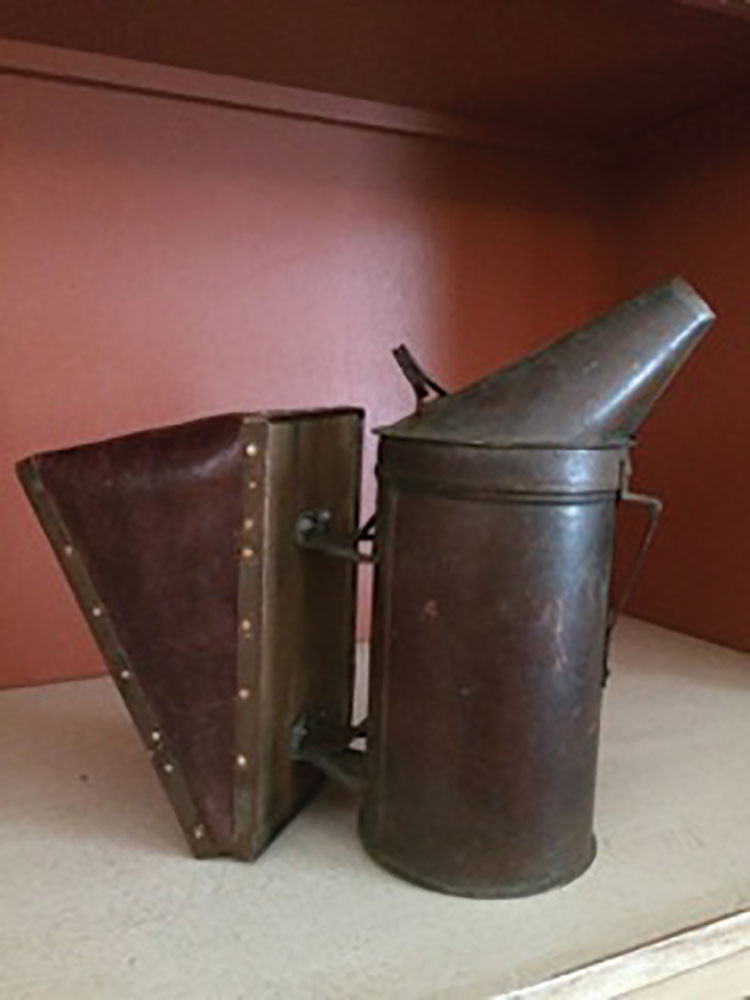By William Hesbach
Leather, the mainstay fabric of early smokers, existed in an age of less disposable products making repair a common skill practiced by beekeepers. In modern times, leather has been replaced with various vinyl or rubberized materials. Now we can simply order a completely assembled bellows and fix a smoker in minutes. So when I became the owner of a circa 1907 all copper A.I. Root smoker, with a partly disintegrated leather bellows, my immediate thought was to buy a stock replacement and be done with it.
But when I took a closer look at the beautiful patina and the fine copper work around the bellow’s box, I began a quest to learn how to replicate and attach an old fashion leather bellows.
Smoke, the anesthesia of beekeeping, has a long history as a useful and necessary tool. The smokers we use today are the result of many earlier experiments – some good others not so good. Early designs were dealing with the placement of burning fuels in relation to the stream of forced air, or draft, created by the action of the bellows.
Moses Quinby, a native of St. Johnsville New York, one of the first commercial beekeepers in the U.S., is credited with inventing the first bellows operated smoker around 1873. Known as the Quinby Bellows Smoker, it was a three-inch tin cylinder with a tall removable cone top. Compared to a modern smoker, the spring-operated bellows was attached inverted with the wide end at the bottom of the cylinder. It was loaded and ignited right side up by removing the cone and then inverted when used. When inverted, the cone filled with ignited fuel making it the hottest part of the combustion chamber. Consequently, the draft created by operating the bellows produced hot smoke that contained the occasional lit ember. Quinby’s “hot blast” smoker was slowly improved while other inventors like Norman Clark reconfigured the bellows and barrel allowing the draft to enter above the smoker’s burning fuel creating a cooler smoke. Unfortunately, Clark’s cold blast smoker died out without constant draft from the bellows making it inconvenient to use.
By the early 1900s smokers had evolved to resemble modern units with the bellows repositioned, wide side up, eliminating the need to invert the smoker after lighting. This also allowed the draft to enter under the ignited fuel and the smoke to rise through unburned fuel cooling the smoke. The all copper smoker I’m repairing was well preserved except for the bellows. So the primary task was to completely disassemble the smoker and design a template shaped like the original leather. The leather is attached to the wooden front and back of the bellows with a delicate thin copper trim. The trim was deformed from repeated attempts to repair areas where the leather had worn and become detached. I used my hive tool and a hammer to work the soft copper back to its original shape. With the trim ready and the wooden back and front prepared, I turned to the new leather template.
In 1907 smokers, mail ordered from A.I. Root company, came in various sizes beginning with the two inch barrel named the Little Wonder to the four inch Smoke Engine. These smokers were made of tin, ranging in price from 50 cents to $1.25 with an additional 25 cents for postage. Copper, a metal more durable than tin, was available as an option for 50 cents. In 1907 a smoker like mine would cost about $2.50 with shipping and would have been considered a premium model. Other models like the asbestos lined Danzenbaker could be purchased for $1.25 with postage and there were other off brand models available for just 35 cents. A premium copper barrel would last a long time, but the leather bellows would dry and crack eventually needing replacement.
The leather on my smoker had mostly disintegrated. The small scrap that remained modeled just enough of the side angle for some guess work at a final design. I started with paper and estimated the shape that would operate the bellows using the extended interior spring to gauge the width of the top. I developed the pattern by measuring the wooden sides and projecting the angle of the scrap to full size allowing me to wrap the pattern around both the front and back of the bellows while keeping the spring just slightly compressed. With the template complete, I then used it to shape the leather. I chose medium weight leather with a worn authentic look that complimented the aged copper.
One interesting part of these older smokers was the rather large hole drilled in the lower back of the bellows used as an air inlet valve. On the inside, the hole was covered with a small leather flap acting like a one-way valve. When the bellows release after compression the leather flap opens and the box inflates with air entering the hole. When the bellows are compressed the internal pressure closes the flap forcing a small intense airstream to exit the small hole, or short tube, facing the bottom of the cylinder.
If you’ve ever wondered why that small tube isn’t actually connected to the cylinder’s fire chamber here’s why. In earlier models, like the first Quinby bellows smoker, they were connected but that connection allowed hot burning embers to be sucked back into the bellows causing them to occasionally ignite. The space between the output of the bellows and the cylinder prevents that from happening.
Back at my workbench, the assembly began by attaching the leather to the wooden back of the bellows with a few small copper tacks. Since I could not determine the exact finished length of the leather, both ends of the narrow part that runs under the bellows was left long and at this point I trimmed them to meet in the middle. I then ran the delicate copper trim around the wood and tacked the back half together. The smoker was still disassembled while I worked on the back, but the next step required complete assembly because the working parts of the bellows are inside. I reinstalled the spring and attached the wooden front to the smoker barrel using the original hardware. The flap valve also needed replacement, so I cut a little square piece of new leather and nailed it over the inside hole using the old nail holes as a guide for it to properly hinge.
I then began some awkward attempts at trying to attach the assembled back to the wood front while the spring kept flopping out of position. With a few tacks through the leather on top, I worked my way around the bellows until the assembly held in place under light spring tension. I then attached the delicate trim detail on the front and it was done. I was surprised how well the leather bellows worked. The delicate trim lightly tacked around the edges makes the bellows box nearly airtight.
Once the design of smokers improved, allowing for longer burns and cool smoke, beekeepers were able to control bees with less distraction. Improved smokers allowed beekeepers to work larger apiaries ushering in the era of commercial honey production. Through the ages beekeepers have expressed some affection for their favorite smokers. During summer gatherings and beekeeping conventions beekeepers often compete to see how long a smoker can remain lit.
In some ways, the ritual of selecting a type of fuel, packing the cylinder, and lighting the smoker is symbolic of the art of beekeeping. Repairing this smoker was like breathing life into a small part of beekeeping history and was both enjoyable and rewarding.













